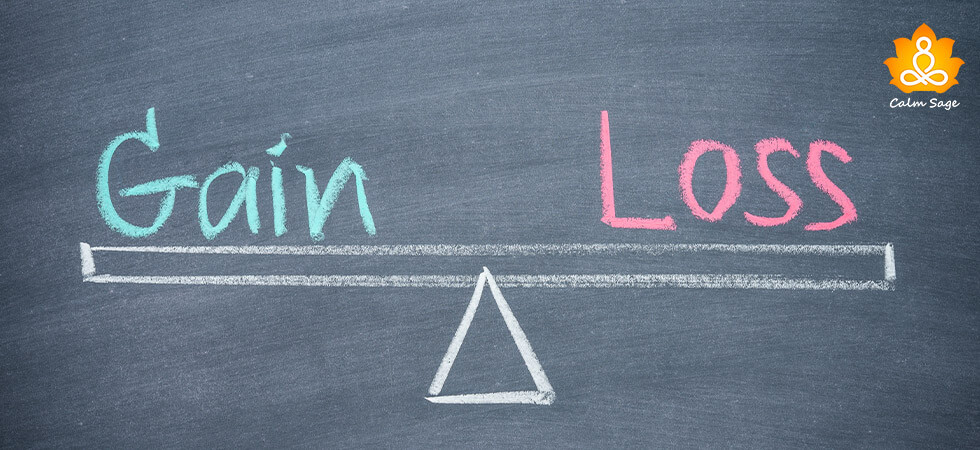Understanding Loss Aversion Bias (With 5 Practical Tips to Overcome It)

It will be fair to say that there have been times in your life when you’ve paid more attention to what you risk losing than what you potentially gain. Even before you start something new or accept a unique opportunity, you might focus on what you may lose rather than gain. It’s the thought of losing that stops us in our steps and from striving.
This particular line of thinking can be a cognitive bias – loss aversion. This loss aversion bias can be described as a thought that causes us to focus more on what we risk losing rather than what we stand to gain.
In simple terms, it is the pain of losing that is psychologically more powerful and intense than the gratification of gaining something of equal value and precedence. Loss aversion bias is a strong thought that can also influence our decision-making and can strongly impact our mental well-being.
Let’s take a look at how loss aversion works, how it impacts our mental health, and how you can overcome this cognitive bias.
What is The Loss Aversion Theory?

Loss aversion bias was first introduced by Danial Kahneman and Amos Tversky, Nobel laureates. In their research, they concluded that people experience the psychological effect of losses more than they were impacted by the gains. This intense sensitivity to loss can also cause irrational decision-making and missed opportunities.
Loss aversion can be strongly intertwined with risk aversion. Instead of focusing on what can go right, we keep focusing on the thought of what could go wrong.
We experience this cognitive bias from a young age, even. A common example can be;
Imagine your child playing with their favorite toy and suddenly they lose the toy. The reaction to losing the toy they are playing with is twice as strong as the joy of getting a new toy. The upset your child self feels at the thought of losing overpowers the joy of gaining.
How Loss Aversion Affects Mental Health?

Loss aversion bias can strongly influence our mental health and well-being. The fear of loss can impact our personal growth, lead to missed opportunities, and increase our stress. This cognitive bias often manifests itself in various aspects of our lives – from finances to relationships and from careers to day-to-day decision-making.
Another simple example of loss aversion can be;
You hold onto losing your investments longer than what is normal. You resist change in your personal life and relationships because you fear the loss of “normalcy”. You avoid taking risks that could lead to growth and personal development.
If you experience loss aversion, then you are likely to feel stagnant. You know that you can do more than you’re allowing yourself to do, but you stop your growth because of the fear of loss. When loss aversion is active in your mind, you avoid with all your might any situation that might lead you to success. You deliberately put yourself away from the path of success.
This compliance with the bias can keep you from exploring beyond your comfort zone. While there’s nothing wrong with being safe in your comfort zone, it can hinder your growth as a person. To grow as a person, you need to step out of your comfort zone and take a step towards the “growth zone”. Loss aversion prevents you from doing so.
Here are some ways you can overcome loss aversion bias;
Tips to Overcome Loss Aversion
1. Recognize the Bias
The first thing you can do to overcome loss aversion bias is to become aware that it exists. Once you recognize that the bias exists, you can consciously work on understanding how it is impacting your decision-making and mental well-being. You can also try to reframe your perspective on your loss. When you change your perspective on loss, you reduce the fear associated with it, effectively reducing the risk of loss aversion.
2. Focus on The Gains
Instead of only focusing on the loss, it’s important to take in what can be considered potential gains. Look at the big picture and the gains you may be rewarded for the decisions you make. Instead of seeing what you can lose, choose to look at what you may gain. It might be challenging to let go of the fear of loss but in the end, it will be worth it.
3. Adapt a Growth Mindset
Having a growth mindset can also help you shift your focus from avoiding losses to looking at them as opportunities for growth and learning. Become comfortable with the idea of losing so that you can grow instead of remaining stagnant. Don’t allow yourself to be swayed by others’ negative comments and actions. Keep your focus on your growth and learning.
4. Seek Others’ Advice
You can also choose to engage in conversations and seek advice from others who have slighter different perspectives. This can allow you to challenge your bias and offer a new understanding of your outcomes and gains, effectively reducing the impact of loss aversion on decision-making.
5. Take Small Steps
Small steps, in hindsight, matter more than any big steps you might take in haste. Try to gradually expose yourself to the idea of loss. Take small calculated risks and slowly expand your comfort zone. There will be times when you need to make difficult decisions and you might not always make the right decision, but remind yourself that it’s OK.
Wrap-Up
Your loss aversion bias can greatly impact your mental and emotional well-being and can limit your growth potential. It can lead you to feel stressed and anxious for no reason at all. Understanding the loss aversion bias can help you take the right steps to overcome the bias and focus on growth and gains instead of losses.
Overcoming loss aversion can be challenging at times, but in the end, the reward you’ll receive will be invaluable and worth it all. Just keep the practical tips I’ve mentioned above in mind and let yourself grow into someone who values gains more than losses.
Take small steps and start slowly. The journey to reduce loss aversion might be difficult but it’s not impossible. I hope the tips listed above will help you! Let me know how you overcome loss aversion bias in the comments below.
Take Care!




















